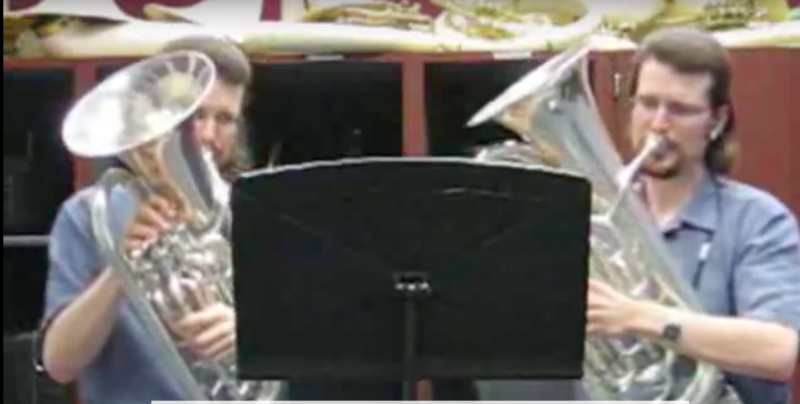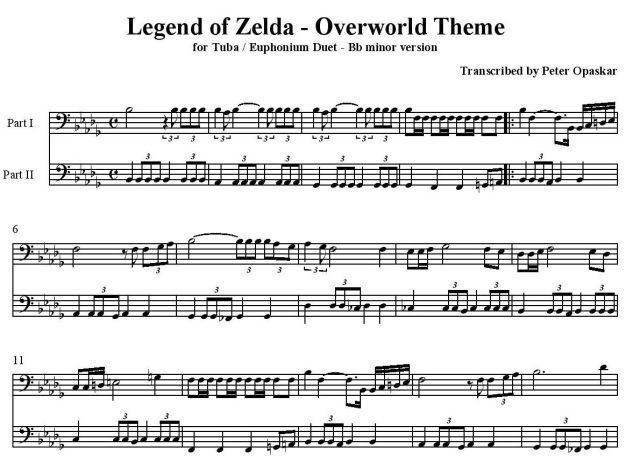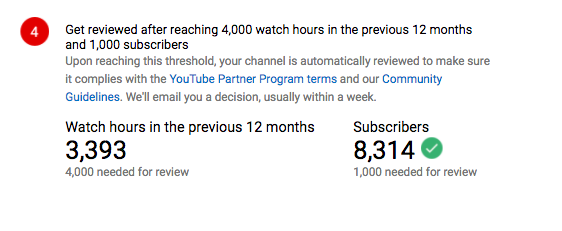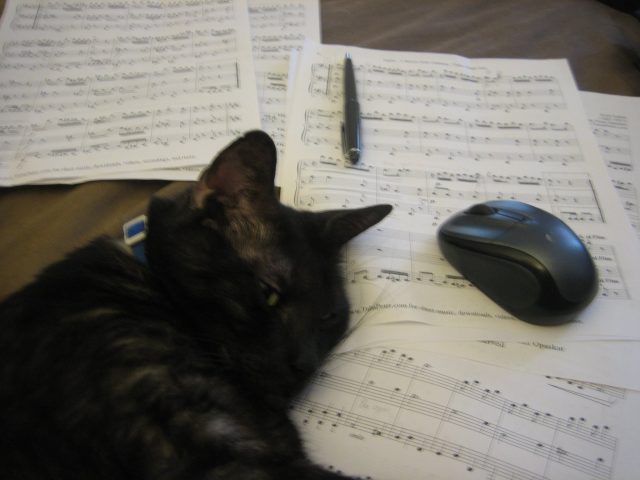
Early in 2018, YouTube made changes to how we commoners can earn money through its Partner Program (or “YPP”). You probably heard about it here and, oh yeah, here.
Now seems like a good time to describe my own (less tumultuous) history with YPP.
I play tuba
Before becoming one of the resident grammar-hammers at Ars Technica, I taught one-on-one tuba, euphonium, and trombone lessons in public schools in the Houston/Galveston area. Around 2001, I started arranging sheet music (mostly duets) to play with my students.
Arranging (or “transcribing”) is when you take a piece of music composed for one instrument (or set of instruments) and rewrite it for a different instrument (or set of instruments). The Night on Bald Mountain you hear in Fantasia, for instance, is actually an arrangement of an arrangement, first by Rimsky-Korsakov and then by Leopold Stokowski.Arranging music is fulfilling for a couple of reasons. First, you get to perform music that might not otherwise exist for your instrument, and second, you get a different, deeper appreciation for a piece of music after you’ve had to take it apart and put it back together again in a new form. It's similar to how a gearhead only really appreciates an automobile engine after spending weeks underneath it covered in motor oil.
Some time around 2008, I got it in my head that I wanted to try selling my transcriptions online. My first collection of arrangements contained music by stalwarts like Bach, Beethoven, Purcell, Vivaldi, and Chopin.
Why them and not, say, Nelly, who was one of the best-selling artists between 2000 and 2010? Because Nelly is still alive, remarkably, that’s why. If you want to sell arrangements of music by someone who’s still alive, copyright law requires you go through music publishers and entities like ASCAP to ensure that the original content creator gets a cut of any money you make. Some publishers even want you to estimate how many arrangements you’re going to sell and want you to pay royalties before you’ve sold copy one.
To that I said [armpit fart]—I already had a job (see: paragraph 3).
But—and this came to me while I was eating 45-cent wings at BW3—what if, as a promotional move, I uploaded YouTube videos of me playing copyrighted songs on tuba?

Would that drive potential consumers to visit my website where, maybe-just-maybe, they would purchase my arrangements? Aw snap, son, I like money.
Why The Legend of Zelda?
What’s the audience for YouTube videos of people playing tuba? Band kids in junior high and high school, for one, and grown people nostalgic for when they were band kids in junior high and high school. And what do those folks like? They like video games, movies, TV shows, and what they hear on the radio. So the theme from The Legend of Zelda—which I guess was in subsequent Zelda games, I dunno, maybe—was an obvious choice.
As much as I’d like to say I figured out Zelda by ear, I had five cats at the time. I was too busy cleaning up vomit. Even in the primordial savagery of 2008, sheet music for everything was already lurking on the Web. I must’ve found a transcription of Zelda for guitar or flute trio or butt trumpet and re-arranged it for tuba/euphonium duet. I don’t remember. I’ve slept since then.
I tried out the sheet music with my students. They seemed to like it.
Recording
In an ideal world, this is when I’d tell you about cutting-edge HD camcorders, condenser mics, DATs, and my home studio.
But ain’t nobody got time for that jibber-jabber. Instead, I used the video setting on the still camera I got for a wedding present in 2001. It recorded in 15fps standard definition and had like, uhhh, one megapixel? (Note: 2001 was a different time.)
Instead of using a tripod for the camera, I used a music stand, because I was making the video in a band hall during a break between after-school lessons (#Manhasset4Life). I played Part I in one chair and Part II in another chair right next to it. Instead of listening to one track while recording the other, I saved time by plugging the earbuds from my iPod shuffle into a pocket-sized metronome.
Editing
The still camera’s built-in microphone was a magnet for room noise, so I used every filter Adobe Premiere Pro 2 had. Lowpass and DeNoiser are reliable. A dedicated audio processor would have had more powerful tools, but I’m not made of time. By cropping the left half of Part I’s video and the right half of Part II’s video, I created the illusion of two players playing at the same time instead of just one lonely dude with a good haircut.
If you look really-really-really closely at my Zelda, you might see a few split seconds of blurriness throughout. That’s because, no matter how closely you hew to a metronome, you’re gonna stray. But removing a few frames in post-production will let you get back on the beat. (Note: the blurriness is from the camera’s auto-focus. There was no way to turn that crap off—again, 2001 was a different time.)
Uploading
I uploaded my first videos in March 2008, which is when YouTube switched from 320x240 pixels to 480×360. Soon 16:9 became an option with the addition of 720p HD in November of that year, and thus I uploaded my first 16:9 video (“The Blue Danube Waltz”) the following January.
I could have spent every waking hour in May 2008 researching codecs so that I could get the highest-possible video quality out of YouTube’s limitations. But I didn’t. That’s why the image at the top of this article makes you think you need your eyes checked.
Profit, or why you hate YouTube
By 2007, YouTube was sharing advertising revenue with video uploaders as long as they didn’t upload copyrighted content. So even if you got away with uploading the music video for “Hot in Herre,” you couldn’t get money by running YouTube ads in front of it. Unless, you were Nelly that is.
Those same rules applied to my videos. I couldn’t run ads in front of The Legend of Zelda because the tune was copyrighted material. The audio from my video of the theme from Raiders of the Lost Ark was even pulled for a few months.But time has a way of changing rules. In the last two or three years, many copyright holders realized that, rather than pull scofflaws like me off the YouTubez, they could earn more dinero by allowing us to keep uploading our copyrighted materials. Those creators and YouTube even let us run ads alongside the copyrighted content. The catch? The advertising revenue would be divided among the uploader, the copyright holder, and YouTube.
Suddenly, all the videos I had uploaded in order to coax potential customers to buy my sheet music were just one box-click away from putting those sweet, sweet advertising dollars in my virtual pocket.
So, did I click that box? Well, DUH.
I don’t think I’ve ever made more than a couple hundred dollars per year in advertising. So... this was more than a hobby, but not quite a side business? Let’s say a “side-piece.” (That’s what that means, right? I’m pretty sure.)
Demonetized?!
Here’s the email that I got from YouTube on February 21 but haven’t bothered to read until today:
As you probably heard, we recently announced updates to the YouTube Partner Program (YPP)...
As of today, your channel, TubaPeter.com, will no longer have access to monetization tools associated with YPP because it doesn’t meet the new threshold of 4,000 hours of watch time within the past 12 months and 1,000 subscribers. If you meet the new threshold at some point in the future, you'll be automatically re-evaluated for YPP. The reviews typically take 1-2 weeks.
Let’s check how many viewing hours I have...

What’s YouTube’s justification for this? I’m glad you asked, imaginary interlocutor.
This program threshold allows us to significantly improve our ability to identify creators who contribute positively to the community and help drive more ad revenue to them (and away from bad actors). These standards also help us prevent potentially inappropriate videos from monetizing, which can hurt revenue for everyone.
So if you’re reading this, I need y’all to spend about 650 hours on my YouTube channel.
How things have changed
In the last decade, I’ve graduated to a 720p camcorder given to me by a friend. Sometimes I use an XLR mic that runs into a handheld TASCAM, but I think the Rock Band-branded USB mic (loaned indefinitely to me by the same friend who gave me the camcorder) might be better. Real mics try to be as faithful as possible to actual sounds while a Rock Band mic just wants to filter out garbage.

The description of this process may seem like a litany of cut corners, and my website (www.TubaPeter.com) is probably the most rinky-dink thing you’ve ever seen (I am not what you’d call “tech-savvy;” in fact, by the standards of Ars Technica, I’m practically a jock.) But my goal was never to make the awesomest video of the badass-est tubist playing the hardest arrangement ever. My goal was to make music for kids who were goofing around after band class or marching rehearsal. Finding a beat-up print-out of one of my arrangements in a band hall filing cabinet or seeing a kind-of splatty video of teenagers playing my Godfather Theme is what I find satisfying.
So given my narrow potential audience and the new YPP, my setup isn't likely to change or have any awesome cutting-edge additions any time soon. Though even if it did, I'd still use music stands instead of tripods. Need to stay on brand, after all.
reader comments
184